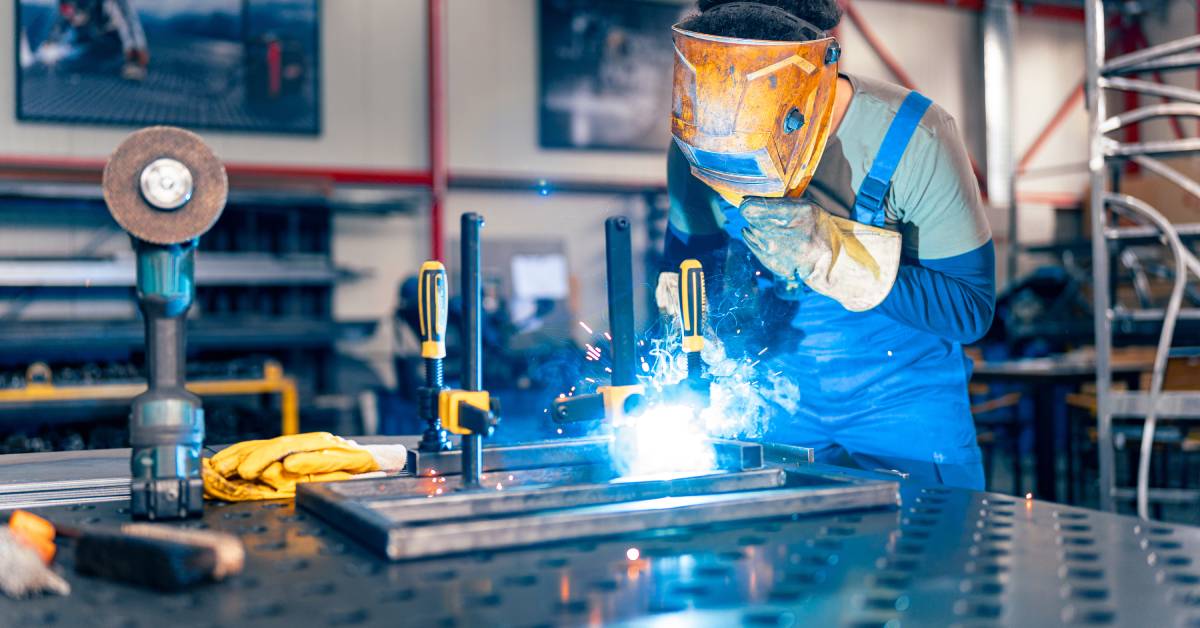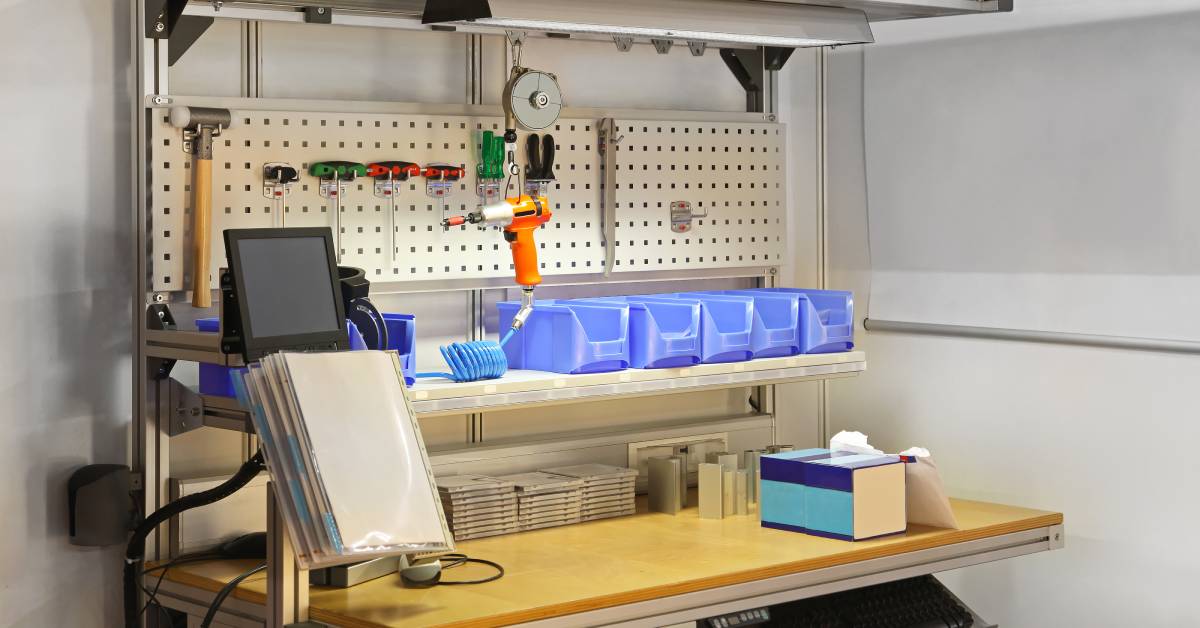
Clutter can cost companies and industrial facilities thousands of dollars in lost productivity, increased error rates, and safety concerns. In manufacturing spaces that depend on efficient workflows, everyone must be organized and keep their work areas clean.
Industrial workbenches exist for workers to use, but these spaces also need to remain tidy to limit the risk of accidents. Use these tips as you learn how to keep your industrial workbench organized. With these actionable insights, you can transform chaotic workstations into efficient, productive environments that contribute directly to facility safety and productivity.
Operating on a set method of organizing your workbench can help you stick to the pattern and create an efficient workspace. The 5S system provides a foundational framework for this organizational system. This Japanese methodology focuses on a process of sorting, setting in order, shining, standardizing, and sustaining to create efficient, functional workspaces.
Sorting begins with removing unnecessary items from your workbench. Conduct regular audits to identify tools, materials, and equipment that don’t belong in the immediate work area. Items used daily should remain within arm’s reach, while workers can store weekly-use items in nearby cabinets or shelving systems.
Setting items in order establishes a space for every tool and component. You can use your preferred holding method to place each element in a new location. When every item has a specific place, workers can quickly locate tools and immediately identify missing equipment.
Shining is the task of cleaning the space and using preventive maintenance protocols to avoid messes. Clean surfaces reduce contamination risks, improve tool longevity, and create professional work environments that support quality standards.
Standardizing helps the entire facility create a consistent organizational system for use across all workbenches. Upper management should work together to develop standard operating procedures for the placement of all tools and specific cleaning protocols.
Sustain is the final step in the process. It is easier for everyone to stay consistent when the organization’s practices are fully embedded into the facility’s daily routines. Management can measure and sustain the implementation of these practices through regular audits of workspaces, performance metrics, and continuous improvement initiatives.

Strategic tool storage directly impacts productivity and safety performance. Well-designed storage systems reduce tool retrieval time, prevent damage, and ensure proper tool maintenance. There are a variety of storage systems that can work well with your current layout or help reorganize workspaces for better functions.
Vertical storage solutions maximize limited workbench space while maintaining easy access to frequently used tools. Wall-mounted pegboards, magnetic strips, and vertical drawer systems keep tools visible and organized without consuming valuable work surface area.
Point-of-use storage places tools directly adjacent to their application areas. This approach reduces the risk of using incorrect tools for specific tasks and increases efficiency. Consider installing tool holders, bins, and organizers that integrate with existing workbench designs.
Effective material organization prevents inventory shortages, reduces waste, and maintains consistent production flow. Structured material management systems support just-in-time manufacturing principles while ensuring quality standards throughout the facility.
Inventory staging areas are zones designated for specific materials and items. By physically separating different materials, quality control issues are reduced and prevent materials from being mixed.
First-in-first-out systems ensure proper material rotation and prevent specific materials from developing wear and tear. Facilities can use dated labels, color-coded containers, or automated inventory tracking systems to maintain appropriate material flow through production processes.
Quality control zones establish dedicated areas for inspection, testing, and rework activities. Separate zones prevent contamination between good and questionable materials while supporting traceability requirements.
Efficient workbenches play a fundamental role in optimizing workflows, improving productivity, and maintaining safety standards in industrial operations. By investing in high-quality, customizable workbenches, organizations can ensure that employees have ergonomic, durable, and functional setups suited to their tasks.
Aluminum work stations are an excellent choice due to their versatility, resilience, and adaptability to different operational needs. With their corrosion resistance, they are a durable choice for various industries.
Industrial workbench organization must prioritize worker safety while maintaining operational efficiency. With a focus on safety, the facility can ensure regulatory compliance and protect valuable human resources.

Personal protective equipment stations provide convenient access to required safety gear. Dedicated PPE storage areas near workbenches ensure compliance with safety regulations and encourage consistent usage.
Emergency equipment access maintains clear pathways to fire extinguishers, emergency stops, and first aid equipment. Organization systems should never obstruct emergency access routes or the visibility of safety equipment.
Sustainable workbench organization requires ongoing monitoring, measurement, and improvement initiatives. By reassessing the organization’s systems continuously, facility managers can ensure the workbenches meet all operational needs without impeding any production or process changes.
Regular audits evaluate the organization’s system effectiveness through structured assessments. Monthly audits should examine tool placement compliance, cleanliness standards, and safety protocol adherence. Document findings and track improvement trends over time.
Worker feedback programs capture frontline insights about the organizational system’s effectiveness. Workers who use workbenches daily often identify practical improvements that management might overlook. Implement suggestion systems and regular feedback sessions to gather valuable input.
Performance measurement tracks quantifiable metrics that demonstrate organizational impact. Monitor tool retrieval time, setup duration, quality incident rates, and worker satisfaction scores to further measure the system’s effectiveness.
Organized industrial workbenches represent more than clean workspaces—they embody systematic approaches to operational excellence that deliver measurable business results. By following these tips, you can ensure that your facility’s workbenches are well-organized and safe for all employees.
Implementing these steps depends on leadership commitment, worker engagement, and systematic application of proven organizational principles. Start with a pilot program for specific areas and then begin to expand throughout the operation.
For efficient aluminum workbenches that can enhance your facility’s workspace, come to A-line Automation. We can fabricate aluminum desks and workstations for your industry’s needs. Our adaptable desks can adapt to your ever-evolving workspaces so that you can focus on the organizational side of your facility. Contact us today to speak with our expert team and learn more about how our workstations can work for you.